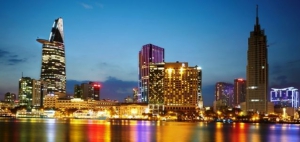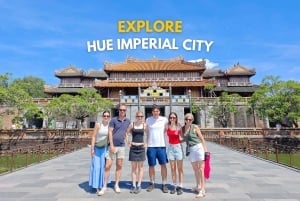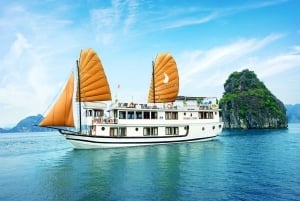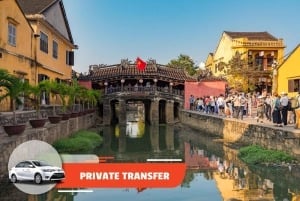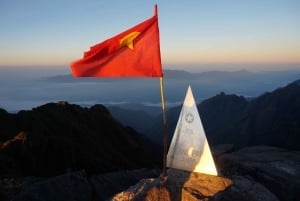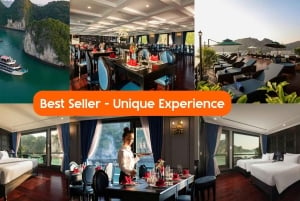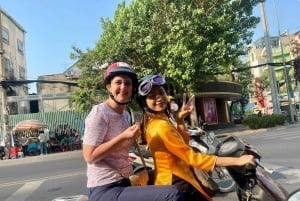Southern Region
Our guide to Southern Region by our Vietnam local expert - The regions of Southern Vietnam are as balanced and diverse as the taste combinations of Vietnamese food- you get it all, and in wonderful proportion. While the Mekong Delta and it’s water world of floating markets, houses, and restaurants may be the “rice bowl” of the country, the city now known as Ho Chi Minh City is undoubtedly the business and economic hub of the nation. As if these polar opposites aren’t interesting and exciting enough, the South also touts the popular beach of Mui Ne and some of the most beautiful islands on the planet, including the forested, white-sand beach-lined Phu Quoc island nestled in the gulf of Thailand, as well as the islands of Con Dao, which are on many jet-setters exclusive lists, thanks to modern resorts and the immaculate paradise of natural beauty here. The biodiverse tropical rainforest of Cat Tien National Park is yet another incredible nature zone to explore by those who enjoy hiking, biking and boating.
The regions of Southern Vietnam are as balanced and diverse as the taste combinations of Vietnamese food- you get it all, and in wonderful proportion. While the Mekong Delta and it’s water world of floating markets, houses, and restaurants may be the “rice bowl” of the country, the city now known as Ho Chi Minh City is undoubtedly the business and economic hub of the nation. As if these polar opposites aren’t interesting and exciting enough, the South also touts the popular beach of Mui Ne and some of the most beautiful islands on the planet, including the forested, white-sand beach-lined Phu Quoc island nestled in the gulf of Thailand, as well as the islands of Con Dao, which are on many jet-setters exclusive lists, thanks to modern resorts and the immaculate paradise of natural beauty here. The biodiverse tropical rainforest of Cat Tien National Park is yet another incredible nature zone to explore by those who enjoy hiking, biking and boating.
Ho Chi Minh City
Ho Chi Minh City, as it was officially renamed from Sai Gon, after the 1975 Fall of Saigon, was once the capital of the Republic of South Vietnam. Now it is the largest city in Vietnam, and is the economic engine of the country. From the street food pho-sellers to the international investment bankers, everyone has got money on their mind. It is this perseverance and ambition that is catapulting Ho Chi Minh City out of their difficult past and into the future. The Chinese-style pagodas and baroque antiquated buildings mixed amidst jutting skyscrapers and glass-walled complexes illustrate the scene of a city of innate and historical character, advancing at a rapid pace.
VietnamOnline.com explained the ambience of the city well in this sentiment: “Long before traffic choked the center of the city, Saigon had already been christened the ‘‘Paris of Asia’’ for its wide boulevards lined with stately trees and magnificent French villas. For a moment you may be fooled by the smells of coffee and baking bread, and by old Renaults sounding their horns at roundabouts.”
Just like the European city, the best way to experience the heart of Ho Chi Minh City is on foot, especially since many of the major tourist sights to see are in District 1, which is fairly compact and easy to maneuver. Of course you can jump in a taxi to get across the city for about 2 USD, or take a “xe om” (motorbike taxis) or a cyclo (kind of pedicab), for even less money and more of a thrilling and intimate way of feeling the pace of modern Saigon.
The shopping in this city is as diverse as the flavors in a Vietnamese dish! Travelers can choose from enthralling local markets, outlet-style, stall-lined shopping centers, a variety of local and expat-owned, chic boutiques, or modern malls that are fully-equipped with international labels and restaurants. And if all the window shopping inspires the inner-designer in you, take a simple sketch or magazine cut-out to one of the many experienced tailors to get a dress, a suit or a special piece custom-made for an incredibly inexpensive price! And speaking of Vietnamese dishes- make sure to fuel your activities with plenty of the country’s famous, healthy and taste-bud tantalizing food.
Phu Quoc
Phu Quoc is a mountainous and densely forested island set in the Gulf of Thailand, about 45 km west of Ha Tien on the Vietnamese mainland and 15 km south of the coast of Cambodia. This untainted and underdeveloped island is ringed with some of the most beautiful beaches in Vietnam and as if that isn’t delightful enough, it also offers the best seafood in the country! Phu Quoc island is on the brink of major development, probably thanks to the recent attention being shed on it’s reserved beauty, in reports such as the 2008 ABC News declaring that Phu Quoc and its beaches are, "The Cleanest and Most Beautiful Beach of the World!" A new international airport has replaced the smaller, old domestic airport, and extensive plans to rebuild Duong Dong's city center, complete with high-rise residential areas and new suburbs are underway. Roads and highways are under construction, as well as a golf area and a casino! The time is now to experience this pristine island in all of it’s natural wonder, while it is advancing into the future, just as so many places of Vietnam.
Con Dao Islands
Con Dao Islands are a group of 16 islands, the largest island called Con Son (not to be confused with the Con Son Kiep Bac in Northern Vietnam). These islands are another part of Vietnam’s history, because during the French colonial era, they served as prison grounds for political prisoners. Again, when the Saigon regime reigned in later years, any captured opponents of the regime, including the Viet Cong during the American War, were imprisoned in the infamous cells known as the "tiger cages." The old prison buildings are actually open to the public, now, along with a small museum which traces the island's history. This historical aspect is definitely amazing to experience, but Con Dao islands are also immensely beautiful, with forested hills for trekking, deserted sandy beaches for lounging and extensive coral reefs and sea life that make for wonderful diving. Almost 80% of the land area of the archipelago is under the Con Dao National Park, which has been preserved from the effects of development mostly thanks to it’s remote and little known location. These almost secret islands offer primary jungle teeming with interesting wildlife, like the endemic black squirrel and the crab eating macaque. Beautiful beaches and hidden lagoons waiting to be uncovered and enjoyed, making Con Dao a paradise for the few off the beaten track-seeking tourists that make it here.
The Mekong Delta
The Mekong Delta is the fertile land that covers about 40,000 km² (15,444 sq mi) of Southern Vietnam, as a low-level plain, no more than 3 meters (9.8 ft) above sea level at any point. It is made up of an interlaced maze of rivers and canals, with farmers tucked in many areas, growing the majority of Vietnam’s supply of rice, fruits and vegetables. The Mekong River, which starts at the Tibetan plateau, flows through this delta land, into a series of 9 small rivers, known to Vietnamese as the Cuu Long, or the 9 Dragons, which finally empty into the sea.
This region is incredibly vast, but even a short visit to any of the populated areas will give you a taste of the relaxed, idyllic life lived by the inhabitants of the Mekong Delta. Get ready to leave the dry land of Ho Chi Minh City! Your transportation here will be through the waterways and canals that connect one area to the next. Some activities you explore here include: fishing, making your way down the mystical canals in a Vietnamese style canoe and eating fresh fruit from floating markets. You can captain a journey to one of the places in the Mekong on your own, but we suggest that you consider joining one of the many tours, who will take care of the river-navigation for you, as well as organize interesting activities to experience within the region.
Some tour activities include: a trip to a durian orchard, a coconut fruit candy factory, rice fields, snake wine farmers or local markets. Choose your tour according to the experience you are looking for, as some places in the Mekong are closer to Ho Chi Minh City than others, and genuine experiences cover a range of options.
A few notable places in Mekong Delta:
My Tho, about 1 hour from Ho Chi Minh City, is the capital city of the Tien Giang province and the first city in the Mekong Delta where many travellers coming from the city will arrive- and hence, a popular spot for dropping tourists on one of the many Mekong boat tours. As a tourist drop-spot, you should expect things to be a bit more expensive than the further Mekong Delta spots such as Vinh Long and Can Tho. Just over the river from My Tho, you can get the most real-life experience in the sparsely visited Ben Tre or Soc Trang.
Cai Be, about 2 hours from Ho Chi Minh City, is a district in the west of Tien Giang province, on the northern side of My Thuan Bridge, which is a gate into the Mekong Delta. The local economy is mainly based on horticulture and tourism; the Cai Be floating market, lovely in it’s own right, has yet to become as touristy as the Cai Rang floating market in nearby Can Tho.
Sa Dec is a small town in the Dong Thap province, that is most known for its flower growing, as many people from Southern Vietnam purchase flowers from these farmers for the Lunar New Year. The flower fields are a bright yellow sight-to-see during the harvest before this holiday. Stay at the enchanting Huynh Thuy Le Old House if you have time. It was owned by a rich Chinese family in 1895, and encapsulates the history of the affair between the Chinese son of the family and a young French girl. Also stop in at nearby Lai Vung district to experience the tangerine groves and buy a cheap ticket to wander through the fruit trees and snack on citrus all day.
Can Tho, about 3 hours from Ho Chi Minh City, is the biggest city of the Mekong Delta. The rapidly growing population estimated at 1.5 million in 2012, hasn’t kept the city from retaining its charm as the center of this rural, culture-infused area. Can Tho boasts floating markets which you can visit by a small sampan ride for an authentic experience, Buddhist pagodas, and deliciously fresh food.
Vinh Long is the capital city of Vinh Long Province, one of the smaller provinces on the Mekong Delta. A sleepy and dusty town, it has recently gained popularity as a popular day trip from Ho Chi Minh City, and touted as an eco-tourist destination. You can also boat to nearby Long Xuyen province, to check out a crocodile farm with reptiles up to 4 m long!
Beaches Near Ho Chi Minh City
Mui Ne is the name of the popular beach area, Northeast of Phan Thiet, that was formerly quite a deserted beach, south of the fishing village of Mui Ne proper. Now, the 15 km sandy crescent of Mui Ne Bay is a coastline, shaded by coconut palm trees and dotted with resorts all along the Ham Tien strip. This place has undergone a development transformation in the last 15 years, but much of the actual beach and water can still be a little rough for lounging and swimming. If you’re definitely wanting a sandy beach you’ll want to choose the right resort for you before booking in that area. Kitesurfing and sailing, however, are very popular water sports here and many schools are available to teach and rent equipment! Various bargain hotels have also been established; they’re located inland from the resort-run coast-- which you will likely need to traverse to get through to the beach. With options for accommodations, activities and sights, Mui Ne delivers a beautiful beach stop on the southern coast of the central area of Vietnam.
Vung Tau is a coastal city meaning Bay of Boats in Vietnamese, which sits on a peninsular about 120km south of Ho Chi Minh City. This proximity to Saigon makes it a great weekend getaway or even a day trip to lay by the ocean, yet not many western tourists know about the allure of this destination! This city, once an R&R spot for US soldiers, is still a fishing town with some fun up it’s sleeve. Domestic tourists are well aware of this close beach spot, and the hotels often fill up on the weekends/holidays- so book in advance or go mid-week for a tranquil experience if you can. Vung Tau's beaches and ocean are not up to Mui Ne or Nha Trang, or even nearby Ho Tram standards, but you can definitely still enjoy the seaside nature, especially from the pool of an affordable resort. Nearby Long Hai makes for an interesting drive, there are some good hiking places and a gondola with views up to the highest mountain. And don’t forget Vung Tau’s most noteworthy trait: the delectable array of cheap and tasty seafood restaurants!
Ho Tram is located about 40 km south, into the Vung Tau province, Ho Tram beach is one of the best beaches within close proximity of Ho Chi Minh City. It’s a small fishing town that brings in many visitors who want to enjoy a quiet and beautiful retreat from the city. The Grand Ho Tram Strip, a Vegas-style resort and casino, is completely unique to Vietnam and boasts the best line of coast on the beach! Plans to develop more beautiful accommodations to continue to grow this currently underdeveloped area are in the works, and many people even speculate that the Ho Tram area will become the next Nha Trang.
Cat Tien National Park
Cat Tien is located in the south of Vietnam, at the end of the Annamite Range, between Ho Chi Minh City and Dalat, and covers an area of about 720 km². The park is important as it protects the habitat of lowland tropical rainforest in Vietnam as well as all of the species, some endangered, that live there. Cat Tien was added to the Unesco list of biosphere reserves in 2001, yet the park has seen some endangered species, like the rhino, fall to extinction since. One of the beautiful natural treasures of Vietnam, this nature spot is still rejuvenating since it was hit by defoliants during the American War, but it has regrown thanks to its preservation, and now is a wonderful time to explore this land. Cat Tien is sure to be enjoyed by those who like outdoor activities. Some options include hiking, mountain biking and bird-watching for the 350-plus rare bird species; and thanks to the various overnight options, many visitors plan to spend a couple of days experiencing this slice of nature nirvana. The park does house over 100 types of mammals and 79 types of reptile, but visitors shouldn’t come expecting to encounter elephants and tigers!


